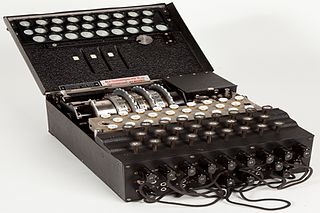
The Enigma machine is a cipher device developed and used in the early- to mid-20th century to protect commercial, diplomatic, and military communication. It was employed extensively by Nazi Germany during World War II, in all branches of the German military. The Enigma machine was considered so secure that it was used to encipher the most top-secret messages.

Fraktur is a calligraphic hand of the Latin alphabet and any of several blackletter typefaces derived from this hand. Letters are designed such that the individual strokes are broken apart; in this way it is often contrasted with the curves of the Antiqua (common) typefaces where the letters are designed to flow and strokes connect together in a continuous fashion. The word "Fraktur" derives from Latin frāctūra, built from frāctus, passive participle of frangere, which is also the root for the English word "fracture".

The Panzerkampfwagen III, commonly known as the Panzer III, was a medium tank developed in the 1930s by Germany, and was used extensively in World War II. The official German ordnance designation was Sd.Kfz. 141. It was intended to fight other armoured fighting vehicles and serve alongside and support the similar Panzer IV, which was originally designed for infantry support.

The provinces of Italy are the second-level administrative divisions of the Italian Republic, on an intermediate level between a municipality and a region. Since 2015, provinces have been classified as "institutional bodies of second level".

The 169th Infantry Division was a German military unit during World War II.
The Peace of Passau was an attempt to resolve religious tensions in the Holy Roman Empire. After Emperor Charles V won a victory against Protestant forces in the Schmalkaldic War of 1547, he implemented the Augsburg Interim, which largely reaffirmed Roman Catholic beliefs. This angered many Protestant princes, and led by Maurice of Saxony, in January 1552 several formed an alliance with Henry II of France in the Treaty of Chambord. In return for French funding and assistance, Henry was promised lands in western Germany. In the ensuing Princes' Revolt, also known as the Second Schmalkaldic War, Charles was driven out of Germany to his ancestral lands in Austria by the Protestant alliance, while Henry captured the three Rhine Bishoprics of Metz, Verdun and Toul.
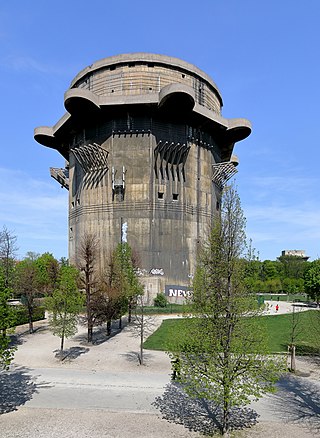
Flak towers were large, above-ground, anti-aircraft gun blockhouse towers constructed by Nazi Germany. There were a total of 8 flak tower complexes in the cities of Berlin (three), Hamburg (two), and Vienna (three) from 1940 onwards. Other cities that used flak towers included Stuttgart and Frankfurt. Smaller single-purpose flak towers were built at key outlying German strongpoints, such as at Angers in France, and Heligoland in Germany.

The Deutsche Luftstreitkräfte —known before October 1916 as Die Fliegertruppen des deutschen Kaiserreiches —was the air arm of the Imperial German Army. In English-language sources it is usually referred to as the Imperial German Air Service, although that is not a literal translation of either name. German naval aviators of the Marine-Fliegerabteilung were an integral part of the Imperial German Navy. Both military branches operated aeroplanes, observation balloons and airships.

Namibian cuisine is the cuisine of Namibia. It is influenced by two primary cultural strands:

The Lake Naroch offensive in 1916 was an unsuccessful Russian offensive on the Eastern Front in World War I. It was launched at the request of Marshal Joseph Joffre and intended to relieve the German pressure on French forces. Due to lack of reconnaissance, Russian artillery support failed to overcome and neutralise the well-fortified German defenses and artillery positions, leading to costly and unproductive direct attacks, hindered by the weather. On 30 March General Evert ordered a halt to the offensive.

The Bismarck Memorial is a prominent memorial statue in the Tiergarten in Berlin dedicated to Prince Otto von Bismarck, Minister President of the Kingdom of Prussia and the first Chancellor of the German Empire. It was sculpted by Reinhold Begas. It is one of 250 memorials to Bismarck worldwide.

Weinmeisterstraße is a Berlin U-Bahn station located on the U8.

Pozières is a commune in the Somme department in Hauts-de-France in northern France.

Elek is a town in Békés County, in the Southern Great Plain region of south-east Hungary. Jews lived in the city as early as the 19th century and in 1944 many of them were murdered by the Nazis in the Holocaust.
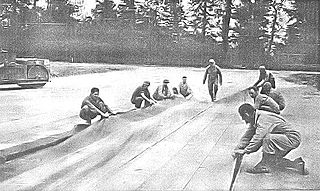
Advanced Landing Grounds (ALGs) were temporary advance airfields constructed by the Allies during World War II during the liberation of Europe. They were built in the UK prior to the invasion and thereafter in northwest Europe from 6 June 1944 to V-E Day, 7 May 1945.

The Kamianets-Podilskyi massacre was a World War II mass shooting of Jews carried out in the opening stages of Operation Barbarossa, by the German Police Battalion 320 along with Friedrich Jeckeln's Einsatzgruppen, Hungarian soldiers, and the Ukrainian Auxiliary Police. The killings were conducted on August 27 and August 28, 1941, in the Soviet city of Kamianets-Podilskyi, occupied by German troops in the previous month on July 11, 1941. According to the Nazi German reports a total of 23,600 Jews were murdered, including 16,000 who had earlier been expelled from Hungary.
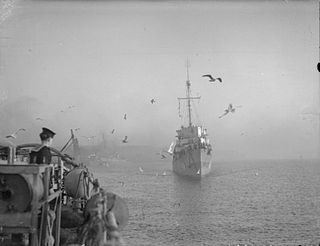
HMS Braithwaite was a Captain-class frigate of the Royal navy during World War II. She was named after Captain Samuel Braithwaite of HMS Kingston, who had an eventful career, taking part in numerous engagements during the 18th century.
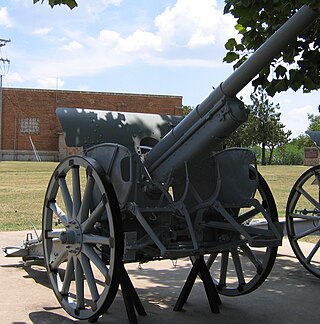
The 7.5 cm Feldkanone 16 neuer Art was a field gun used by Germany in World War II. Originally built as the World War I-era 7.7 cm FK 16, surviving guns in German service were re-barrelled during the early 1930s in the new standard 7.5 cm calibre. It was not modernized for motor towing and retained its original wooden spoked wheels and two crew seats on the face of the gun shield.
SS Radaas was a 2524-ton cargo steamship. She was built by and launched in 1890 as Marstonmoor for Moor Lines. She was sold to a Greek company in 1902 and renamed Athos Romanos, before being sold to Danish interests during the First World War and renamed Radaas. She was sunk by the German submarine UB-40 under the command of Oberleutnant Hans Howaldt on 21 September 1917. She was 18 miles west of Portland Bill en route from Tyne to Bordeaux when the torpedo struck her in the port side. The wreck lies on a sandy bed at a depth of 30 m at 50°34′13″N3°4′50″W.

Duchesse Anne is the last remaining full-rigged ship under French flag. She was built in 1901 with a steel hull by the yard of Joh. C. Tecklenborg of Bremerhaven-Geestemünde (Germany) according to plans drawn by Georg W. Claussen. The mainmast is 48 m tall and 25 sails were rigged. She was used as a training ship for young aspiring sailors in the German merchant marine.


















